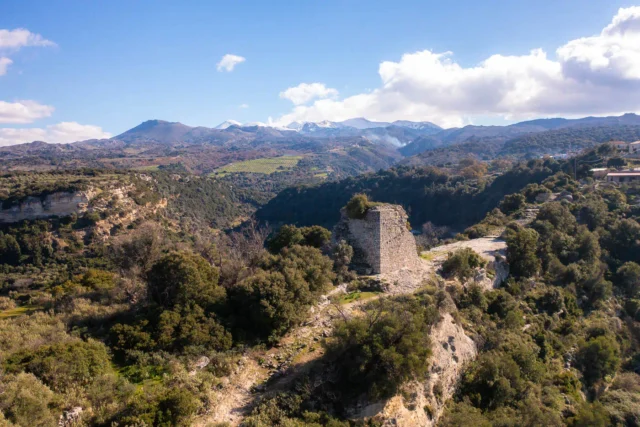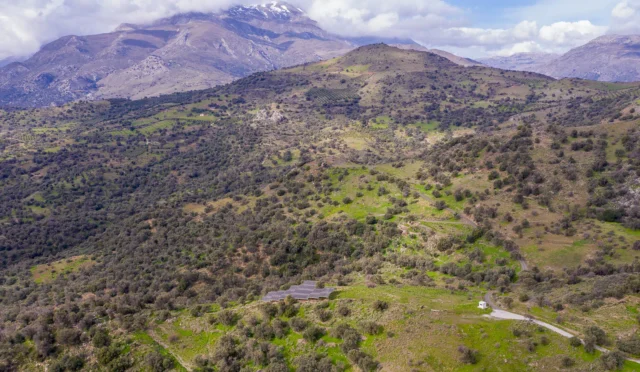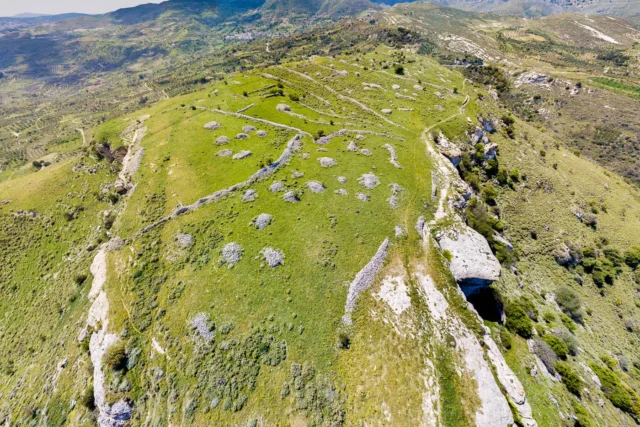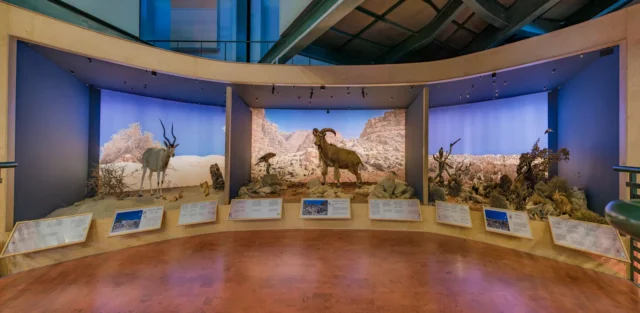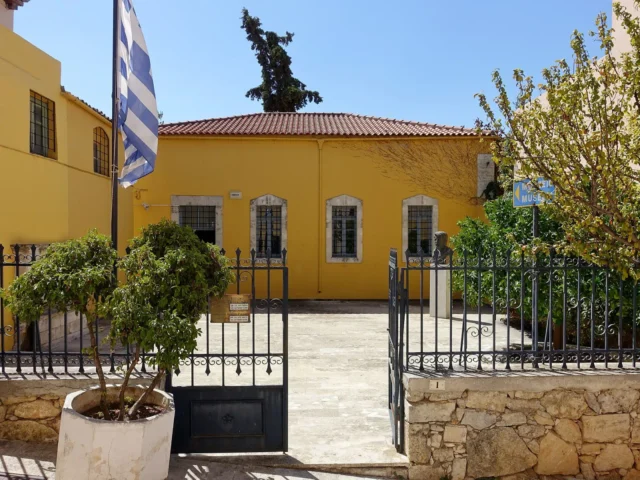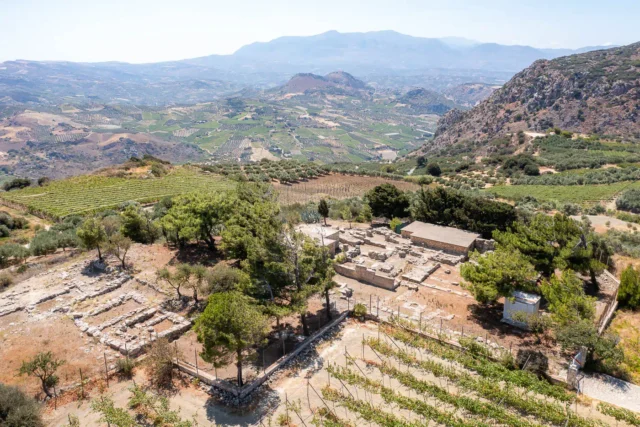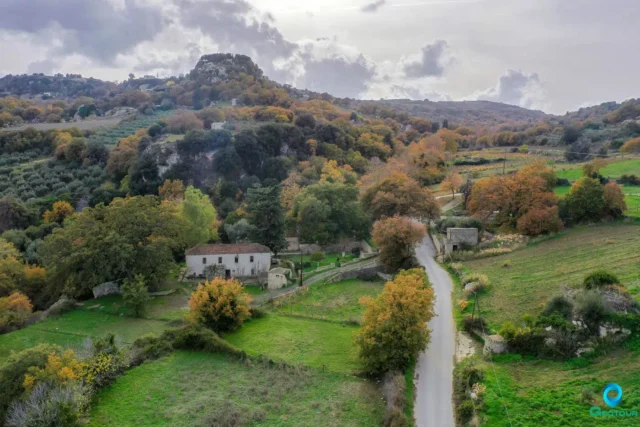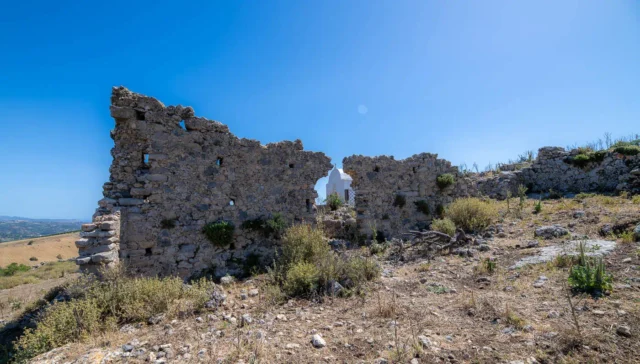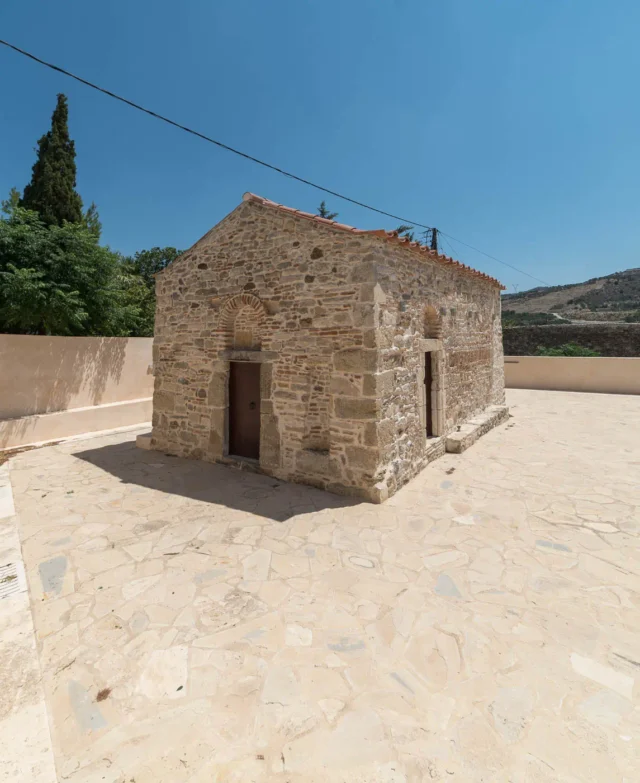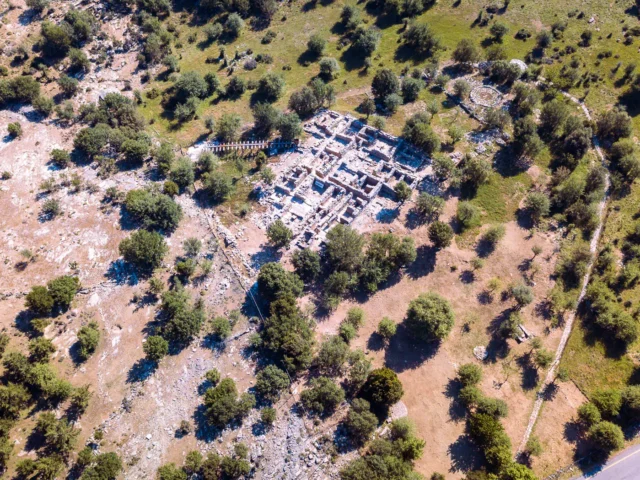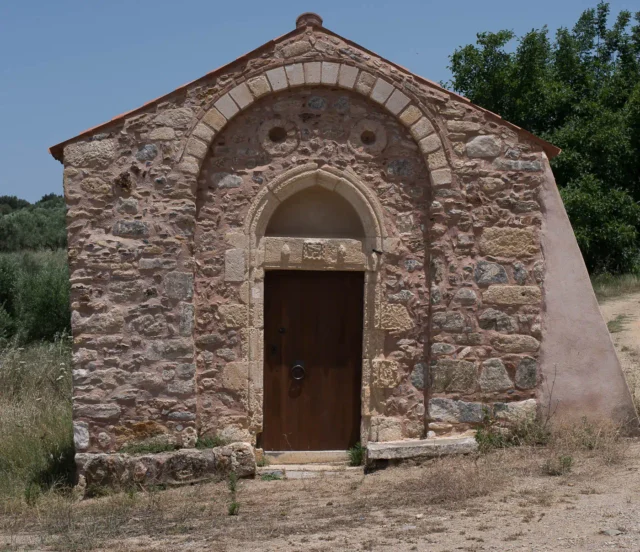829
listings found
Categories
Active filters:
Tower of Eleutherna
The Tower of Eleutherna, located at the acropolis's southern entrance, functioned as a key defensive point, likely dating to the Byzantine period and built on older foundations. Its strategic position on a narrow col guarded the city's access. Historical records by Buondelmonti (1415) and Pococke (1739), along with maps, note its existence and fortification significance. The partially restored structure provides archaeological insights into its construction and historical role.
Minoan villa in Apodoulou
An archaeological site in Amari, 20km from Phaistos, significant during the Protopalatial period (1900-1700 BCE). Positioned on a strategic route to the north coast, initial work by Spiros Marinatos in 1934 and later by Louis Godart revealed a complex destroyed by earthquake and fire. Excavated buildings (A-G) include residential quarters, workshops, and kitchens. Block A was a central hub for storage and administration, confirmed by numerous pithoi and sealings identical to those found at Phaistos.
Ancient Rizinia
Rhizenia, also known as Prinias, was a city in central Crete during the Late Minoan IIIC period (around 1200 BC). Located on the Patela plateau, it held a strategic position overlooking key communication routes. Rhizenia likely played a crucial role in the region's political and economic landscape. The necropolis of Siderospilia has revealed much about burial practices and social structures of the time. The city's political system was unique, possibly incorporating both aristocratic and democratic elements. Archaeological investigations have revealed insights into urban layout, religious practices, and daily life. Imported artifacts from Cyprus and Egypt underscore Rhizenia's integration into a wider network of exchange during the Early Iron Age.
Minoan Shipyard at Agii Theodori
The Minoan civilization on Bronze Age Crete heavily relied on maritime prowess, establishing extensive Mediterranean trade networks with Egypt, Cyprus, and the Levant through advanced shipbuilding and strategic harbor towns. The archaeological site at Agii Theodori, on Vathianos Kambos beach near Heraklion, exemplifies this. Dating to the Late Minoan I period (c. 1600-1450 BC), it features a significant, carved dry dock (approx. 48m x 11m) and timber storage areas, indicating a dedicated shipyard. Its peninsula location offered protection and sea access. This site, near the Palace of Knossos and the port of Amnisos, underscores Minoan maritime dominance, shipbuilding ingenuity, and the vital role of coastal settlements in their economic and cultural expansion.
Natural History Museum of Crete, University of Crete
Operating under the University of Crete in Heraklion, the Natural History Museum of Crete (NHMC) is dedicated to studying, protecting, and promoting the natural heritage of the Eastern Mediterranean. It is located within a restored industrial building, formerly an electricity power plant. Exhibits span four levels, featuring dioramas of regional habitats, interactive geological displays, and paleontological collections including fossils. The museum serves as a center for research and education, contributing to the conservation of regional biodiversity and offering programs for all ages focused on environmental awareness.
Heraklion Archaeological Museum
Located in Heraklion, Crete, this museum, established in 1883, is one of Greece's most significant. It primarily houses an extensive collection of Minoan artifacts, including frescoes, pottery, and jewelry, showcasing Bronze Age achievements. Artifacts from Roman, Byzantine, and Venetian periods are also displayed, covering over 5,500 years of Cretan history. Housed in a notable neoclassical building designed by Patroklos Karantinos, it offers educational programs and temporary exhibitions, serving as a vital center for Minoan studies and Cretan cultural preservation.
Minoan Palace of Epano Archanes
The Minoan Palace of Epano Archanes, also known as the Tourkogeitonia Palace, is a significant archaeological site located in the village of Epano Archanes on the island of Crete, Greece. This palatial complex dates back to the Neopalatial period of the Minoan civilization (around 1700-1450 BC). It is smaller than the palaces of Knossos, Phaistos, and Malia, but boasts a unique architectural layout with multiple wings and levels, and impressive features including an elaborate drainage system. The palace likely played a crucial role in the economic and religious life of the surrounding community. Excavations at the site have unearthed a wealth of artifacts, including pottery, tools, figurines, and seal stones, shedding light on the daily life, artistic traditions, and religious practices of the Minoans. A recent discovery in 2024 unearthed a unique Gate Shrine located outside the main entrance, the first of its kind at a Minoan palace, shedding new light on the religious practices and beliefs of this ancient civilization.
Epano Archanes archaeological museum
Established in 1993 within a neoclassical building in Archanes' Tzami district, the collection presents artifacts unearthed locally, including from the significant Minoan palace site. It features ceramic and stone vases, tools, and figurines illustrating Minoan daily life, customs, and art. A notable exhibit reconstructs a Minoan cemetery with replicas of ossuaries and burial goods. Copies of major finds like frescoes and jewelry, secured in the Heraklion Archaeological Museum, are also displayed. It offers context for the Archanes area's rich history.
Venetian Aqueduct of Morossini
The Venetian Aqueduct of Morossini, nestled in the Karydaki Gorge on the island of Crete, stands as an enduring testament to Venetian engineering prowess and ingenuity. This magnificent structure, spanning […]
Anemospilia
Anemospilia, a Minoan archaeological site on Mount Juktas in Crete, offers a unique glimpse into Minoan religious practices and beliefs. Discovered in 1979, the site features a rectangular building with four rooms, destroyed by an earthquake in the 17th century BC. The eastern chamber contains remnants of a stepped altar with offerings, fragments of pithoi with traces of food, and reconstructed vessels depicting religious ceremonies. The vestibule housed a crushed skeleton and numerous vessels. The central chamber contains a stone altar, believed to be the base of a life-sized wooden statue, with traces of vessels and a box containing a piece of rock symbolizing the earth. The western chamber contained three skeletons, including a young man found on a platform with a decorated knife, leading to interpretations of human sacrifice.
The Minoan villa at Vathypetro
The Vathypetro Minoan Villa, located near Archanes, Crete, reveals insights into elite Minoan life and economic activities during the Late Minoan IA and IB periods (1600-1425 BC).
Initially a residential complex with palatial features like reception halls and a tripartite shrine, it later evolved into an industrial hub with olive presses, workshops for pottery, wine, and textiles, and storage areas. Architectural details include pier-and-door partitions, columns, and a shrine aligned with equinoxes, suggesting ritual and agricultural connections. The villa’s strategic location on a Minoan route from Knossos to the Messara plain and evidence of Linear A documents highlight its administrative and economic significance. The site offers a glimpse into the sophisticated organization and resourcefulness of Minoan society.
Castel del Corner
The Castello del Corner, or Fortress of Kornaron, stands on Kastellos hill near Katalagari, Crete. Tradition attributes its construction to Nikephoros Phokas in 961 AD, following the Arab expulsion. During Venetian rule, it served as a fiefdom for the Corner family, linked to the famed poet Vitsentzos Kornaros. The rectangular fortress, with a 5.5-meter high wall, spans approximately 50 acres, and features Minoan-era wine presses and the church of Zoodochos Pigi. Ruins include wall remnants and possible cisterns, reflecting its role in Malvasia wine production. Restoration efforts have stabilized parts of the perimeter wall.
Panagia Kardiotissa in Agios Thomas
Panagia Kera Kardiotissa, a 14th-century Byzantine monastery near Agios Thomas in Crete, is dedicated to the Nativity of the Virgin Mary. Located in a lush landscape at an altitude of 630 meters, the monastery is situated in a place called Mouzouras, next to the Axedianos River. The monastery once housed a miraculous icon of Panagia Kardiotissa, depicting the Virgin Mary holding Christ. The icon's origins are debated, with some attributing it to an Armenian monk named Lazarus and others to the Heraklion painter Andreas Ritzos. The icon's miraculous powers were documented as early as 1415. The monastery became a significant pilgrimage site in 1912 following a vision of the icon of Saint George. It served as a nunnery from 1935 to 1962 and sheltered residents during the German occupation. Today, the renovated site features a centuries-old oak tree, peacocks, and a workshop for traditional weaving.
Melissa Fortress
Melissa Fortress, near Agios Thomas, Crete, offers panoramic views of valleys. Built in the 11th century during the Byzantine Komnenian period, it controlled strategic routes. The site features a central tower-like structure, perimeter walls, and the well-preserved Zoodochos Pigi chapel, possibly a former monastery. The ruins indicate a pentagonal layout, with a small settlement, Melissa, existing nearby. Historical records note its presence in Venetian and Turkish documents, though it was not utilized or maintained by the Venetians, leading to its abandonment. The ruins reveal a glimpse into Byzantine era fortifications and regional control.
Timios Stavros in Vorizia
Byzantine church near Varsamonero Monastery, Crete, with 14th-century frescoes and intricate stonework. Active place of worship with annual feast day celebrations.
Zominthos, a Minoan Mountain Enclave
Zominthos, a Minoan settlement at 1200 meters on Mount Psiloritis, features a 1600+ square meter central building with over 50 rooms, showcasing Minoan architecture and craftsmanship. Excavations reveal workshops for pottery, stone carving, and potential metallurgy, alongside residential quarters and fresco-adorned spaces. Artifacts, including bronze figurines and ritual vessels, provide insights into Minoan daily life and religious practices. The site's strategic location along mountain paths links it to key destinations like the Idaean Cave, indicating secular and religious importance. Mycenaean presence confirms continued significance post-Minoan era. Ongoing research uses modern technologies to uncover the site's complex details, challenging the notion of a solely coastal Minoan civilization.









